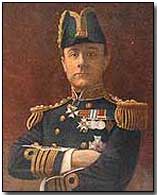Encyclopedia - Indicator Nets
 Indicator Nets were
predominantly deployed by the British Royal Navy as a means - albeit
generally
unsuccessful - of discouraging enemy (usually German) submarines from
entering Allied waters.
Indicator Nets were
predominantly deployed by the British Royal Navy as a means - albeit
generally
unsuccessful - of discouraging enemy (usually German) submarines from
entering Allied waters.
Constructed using light steel nets these were anchored at various depths to the sea bed around key Allied naval bases and were intended to entangle enemy U-boat traffic, although even then submarines were often able to disentangle themselves and escape before they were blown up by depth charges.
They were seldom used as the sole anti-submarine measure but were instead mixed with other defences, which usually included extensive minefields and patrolling warships. In time mines were actually attached to the nets, thereby reducing the survival chances of an entangled submarine.
Indicator Nets were used extensively - dropped from light fishing craft - at both Dover and Otranto Barrages. Individual nets were sometimes as much as 100 metres in length.
While these were ultimately of some benefit at Dover (where the barrage was constantly fine-tuned to produce results) they proved ineffective at Otranto, with gaps between the light steel nets sufficiently wide to allow enemy submarines through. Under cover of darkness U-boats could also thwart the nets by coasting along the surface, as happened at the under-patrolled Otranto Barrage.
Once a submarine became entangled a marker buoy attached to the net would drift along the surface indicating enemy activity below.
The first example of indicator nets assisting in the destruction of a German U-boat occurred at Dover when the U-8 became entangled on 4 March 1915.
A 'Woolly Bear' comprised a German shrapnel shell, which burst with a cloud-like explosion.
- Did you know?
